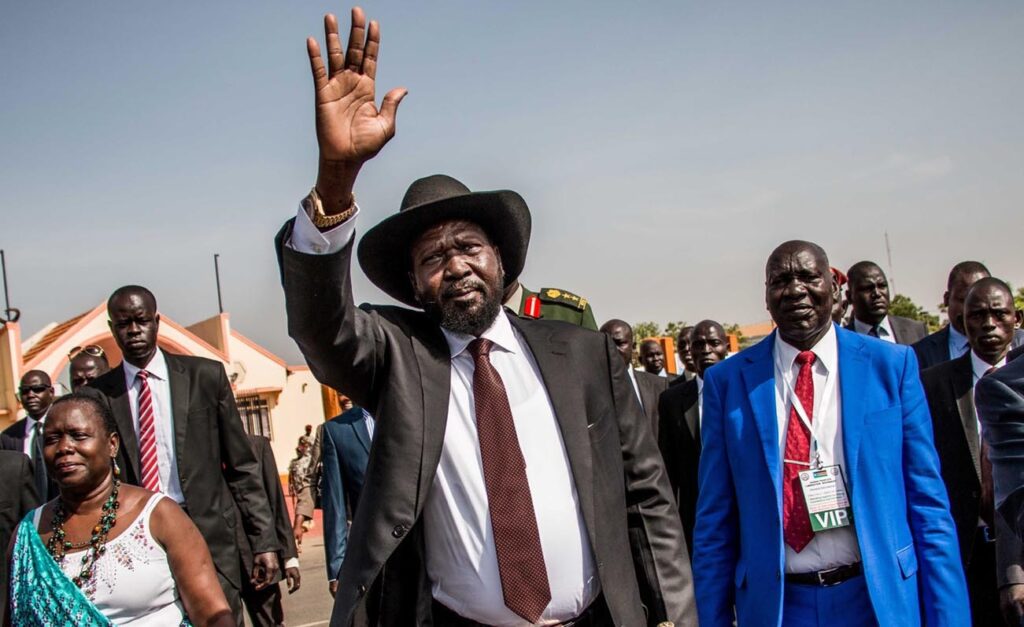Clothing makes the man: (Above, from left) Uganda’s Milton Obote, Julius Nyerere of Tanzania, Kenya’s Jomo Kenyatta and Zambia’s Kenneth Kaunda look more restrained in 1967 than later African presidents. (Photo by KEYSTONE-FRANCE/Gamma-Rapho via Getty Images)
Kenneth Kaunda, the Zambian liberation leader who died earlier this month, inspired many Africans to fight colonialism. He was also an unlikely fashion icon.
His signature look was a short-sleeve jacket with two breast pockets, worn with trousers of the same hue. According to Kaunda himself, it was Tanzania’s President Julius Nyerere who gave the ensemble its name: the Kaunda suit.
Any resemblance to the sartorial leanings of Mao Zedong is probably not accidental — the two leaders met in 1974, and Kaunda is said to have been inspired by the Chinese leader’s outfit, as well as his ideology.
Ever the diplomat, Kaunda balanced his communist-inspired suit with a jaunty ascot cravat, appealing to the sensibilities of both socialist intellectuals and Western diplomats.
Perhaps because of its political overtones, the Kaunda suit caught on: Nyerere adopted a similar style, while any self-respecting African headmaster in the 1970s had at least one in their wardrobe. Tailors across east Africa cashed in on the look, which was in high demand in local markets.
A medal-bedecked Jean-Bédel Bokassa (left) of the Central African Republic inspired Uganda’s Idi Amin
The wardrobes and accessories of other leaders from that era were just as symbolic. Kenya’s Jomo Kenyatta, for example, always carried a fly whisk with him: a marker of authority among the Maasai, and a sign of royal standing. On the other side of the continent, over in west Africa among the Yoruba the fly whisk (irukere) is also considered to be a symbol of power and respect.
Zaire’s Mobutu Sese Seko, on the other hand, created his own fashion in the form of his trademark leopard-print hat, shaped in the style of a western garrison cap. He then banned anyone else from wearing the design, reinforcing his own supremacy in the hierarchy of the state.
As socialism lost ground, so the Kaunda suit fell out of favour. And when the army men and rebels toppled post-independence regimes in coups and rebellions, they brought their military fatigues with them.
Famously, the Central African Republic’s self-styled Emperor Jean-Bédel Bokassa inspired Uganda’s Idi Amin when he visited Kampala in 1972. Bokassa’s military outfit was draped in medals and insignia, and Amin decided he needed to have the same.
When he took power in Uganda in 1986, Yoweri Museveni went in a different direction. He framed himself as a man of the people, wearing loosely fitted clothes and a (now iconic) wide-brimmed summer hat.
In the 2011 election, rural voters received text messages from the president, which were signed simply: “Vote for the old man with the hat”.
 South Sudan’s President Salva Kiir never steps out without his cowboy hat. (ASHLEY HAMER/AFP/Getty Images)
South Sudan’s President Salva Kiir never steps out without his cowboy hat. (ASHLEY HAMER/AFP/Getty Images)
Cut from different cloths
Regardless of ideological persuasion, African leaders have used the iconography of fashion as part of their public relations campaigns for centuries.
African kings had extravagant fashion styles to separate them from ordinary people. Among the Tutsi kings of Rwanda, the Amasunzu hairstyle — a pointy, crested afro — signified that a man was powerful, noble and brave and (a version of the look was later borrowed by Kaunda himself as well as Uganda’s Milton Obote).
Leaders today are similarly mindful of what message is being sent by their choice of clothes. South Sudan’s President Salva Kiir is never without his cowboy hat. The present was a gift from former US President George W Bush, and perhaps serves as a reminder that Kiir also owns the country’s largest cattle herd.
Kenya’s Uhuru Kenyatta, meanwhile, has ditched his father’s fly whisk and instead taken fashion inspiration from another iconic African leader, Nelson Mandela, who became so synonymous with the informal, loose-fitting patterned shirts that he liked to wear that they are now known as “Madiba shirts”.

But Kenyatta Jr’s Madiba shirts do have a Kenyan link: they are made by a state-owned company called Rivatex, and he has been encouraging civil servants to wear “Made in Kenya” apparel every Friday.
Even opposition figures are carefully curating their public image. In South Africa and Uganda, Julius Malema and Bobi Wine have turned the red beret into a potent symbol of resistance to the government, drawing on the garment’s long history, dating back to the French Revolution, as a sign of unity among the proletariat.